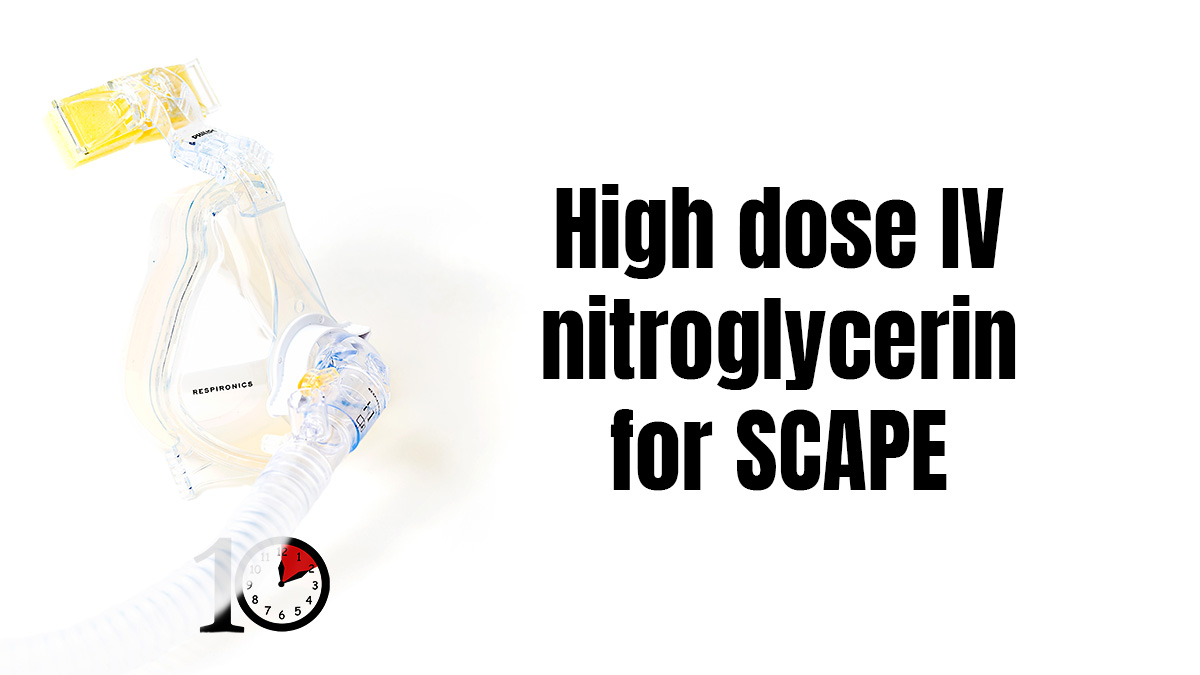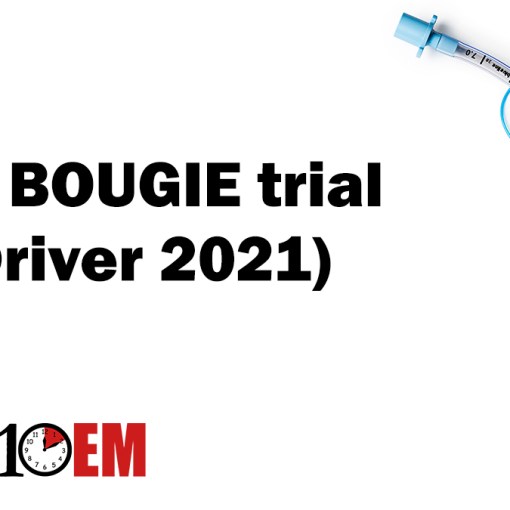Morgenstern, J. High dose nitroglycerin is correct dose nitroglycerin, First10EM, March 18, 2024. Available at:
https://doi.org/10.51684/FIRS.134675
Looking back, I am somewhat surprised I never published a First10 approach to sympathetic crashing pulmonary edema. I guess it never felt necessary, as it was the first ever EMCrit post, and therefore felt well covered in the FOAMed community. However, a full 15 years after that first EMCrit podcast (congrats on the decade and a half of FOAMed Scott), I still encounter many clinicians (nurses and doctors alike) who are uncomfortable with appropriate doses of IV nitroglycerin. To be fair, until now, the evidence has mostly been observational and retrospective. However, we now have an RCT that shows pretty remarkable improvement with high dose intravenous nitroglycerin, so perhaps practice will start to change.
The Accompanying YouTube Video
The paper
Siddiqua N, Mathew R, Sahu AK, Jamshed N, Bhaskararayuni J, Aggarwal P, Kumar A, Khan MA. High-dose versus low-dose intravenous nitroglycerine for sympathetic crashing acute pulmonary edema: a randomised controlled trial. Emerg Med J. 2024 Jan 22;41(2):96-102. doi: 10.1136/emermed-2023-213285. PMID: 38050078
The Methods
This is an open-label, single center, pragmatic randomized controlled trial from India.
Patients
Adult patients with acute onset (less than 6 hours of symptoms) dyspnea, hypertension, tachypnea, hypoxia, and bilateral crackles.
- Specific criteria were systolic pressure >159 and diastolic pressure >100 (or MAP >120), RR >30, sats <90%.
- Exclusions: acute MI, hypersensitivity to GTN, sildenafil within 24 hours, tadalafil within 48 hours, moderate to severe aortic stenosis, hypertrophic cardiomyopathy, patients requiring immediate intubation.
Intervention
High dose intravenous nitroglycerine: 600–1000 mcg bolus followed by an infusion starting at 100 mcg/min and subsequently titrated by clinical response.
Comparison
Low dose intravenous nitroglycerine: no bolus and an infusion starting at 20–40 mcg/min. Dose was titrated by the physician, but was not allowed to exceed 250 mcg/min.
Common standard procedures
Both groups were given BIPAP support with an initial inspiratory positive airway pressure of 12 mm Hg and expiratory positive airway pressure of 6 mm Hg.
Outcome
They used ‘co-primary outcomes’ of resolution of symptoms at 6 and 12 hours. (Subjective improvement on a 7 point Likert scale, plus at least 2 objective markers of improvement: resolution of tachypnea, resolution of hypoxia, resolution of hypertension.)
The Results
They enrolled 52 patients out of 169 initially screened. The mean age was in the mid 40s with about a 50/50 male/female split. This was a relatively sick cohort, despite being so young. 70% of the patients had chronic kidney disease and essentially all of them had baseline hypertension. Vitals signs at presentation included an average respiratory rate in the high 30s, oxygen saturation of 80-85%, and blood pressure of about 200/125.
High dose nitroglycerin was much better than low dose. At 6 hours, 65% of the high dose group had resolution of their symptoms as compared to only 12% of the low dose group (p<0.001). The difference was still large at 12 hours, with 89% resolution as compared to 19% (p<0.001). (These numbers are all surprisingly low to me, as I get close to 100% resolution of SCAPE within the first hour or two with high dose GTN and BiPAP.)
Basically all outcomes were worse in the low dose group. Intubation was 19% vs 4% (although not statistically significant). (I have not intubated one of these patients in my career, so this group seems way sicker, or different in some other way, than what I am seeing in Canada.) Admission rates, hospital length of stay, and MACE were all higher with low dose nitroglycerin.

If you care about monitor based outcomes, the vital signs also improved more in the high dose group:

In terms of adverse events, no patients developed hypotension in either group. 11 patients in the low dose group and 3 in the high dose group developed a headache.
My thoughts
This is an important study, but it is obviously far from a perfect study. It is a small single center study, with a population that seems very different from what I am used to in North America. (Resources and management strategies might also be different, but I don’t know.) Opaque envelopes are not the best allocation concealment procedure. It is cheating to choose co-primary outcomes, especially when you are just using different time frames that aren’t really clinically different. The calculated sample size is based on an expected 54% absolute difference between the groups. Even though I am a pretty big supporter of high dose nitroglycerin, that seems ridiculously over-optimistic to me.
The biggest individual methodologic issue with this study is that it was not blinded. Even when you are measuring relatively objective clinical outcomes, a lack of blinding introduces a high risk of bias. Vitals signs should be objective, but we have all rechecked vitals when they don’t match what we expect. Patient reports of improvement can be influenced by the way questions are asked. (“You have been on the highest dose for a few hours now. You must be feeling better, right?”) The differences in this trial seem too dramatic to be entirely based on bias, but we cannot have a high level of certainty until we see high quality, multi-center, blinded trials.
I do wonder about generalizability. These patients are younger and sicker than my average patient. That might explain the outcomes, but I haven’t seen a SCAPE patient that required intubation, or who wasn’t better within 6 hours, in my entire career. The fact that our patients are less sick might be why so many people have gotten away with using miniscule doses of nitroglycerin in North America.
Obviously, a single center study of only 52 patients is not enough to really comment on adverse events. However, we already routinely give high doses of nitroglycerin all the time (2 sprays of sublingual GTN is 800mcg as a bolus, about half of which is absorbed). Furthermore, if you count all adverse events, including hypoxia and intubation, and don’t just focus on hypotension, I am not sure you even expect high dose therapy to be ‘riskier’.
There are a number of other publications that suggest high dose nitroglycerin is relatively safe (and probably effective). Wilson (2016) published an observational cohort in which they used 2 mg IV (2,000 mcg) push doses of nitroglycerin, and it was associated with less ICU use. The incidence of hypotension was only 2%. Another small study of 25 patients used bolus doses between 600 and 1000 mcg (average 872 mcg) depending on the presenting blood pressure, with no complications. (Matthew 2021) Houseman et al (2023) describe a cohort of 67 patients who had nitroglycerin infusions >100mcg/min, with a hypotension rate of 4%. (Of course, a lot of hypotension is short lived and clinically irrelevant, being managed by simply stopping or decreasing the infusion.)
I am often critical of practice change based on small unblinded studies. I think it is reasonable to be cautious, and we definitely need more studies in this area. However, another concept that I consistently emphasize is the important of pretest probability in evidence based medicine. We are used to using high dose nitroglycerin safely sublingually. There is observational data suggesting this is the right approach. Thus, compared to the average small unblinded RCT, I think the conlclusions of this trial are more likely to be correct. The potential benefit for patients appears large, with minimal risk, so I think this is enough to change practice while waiting for bigger studies.
Bottom line
I have been suggesting high dose nitroglycerin (combined with BiPAP) for SCAPE for many years. This RCT, although far from perfect, demonstrates significantly improved outcomes with higher doses of nitroglycerin, and should be enough to change practice for people currently using lower doses.
Other FOAMed
High dose nitroglycerin covered in Articles of the month Oct 2016,
The very first EMCrit Episode: Sympathetic Crashing Acute Pulmonary Edema (SCAPE)
Critical care infusion drug dosing cheat sheet
Evidence based medicine is easy
Evidence based medicine resources
References
Houseman BS, Martinelli AN, Oliver WD, Devabhakthuni S, Mattu A. High-dose nitroglycerin infusion description of safety and efficacy in sympathetic crashing acute pulmonary edema: The HI-DOSE SCAPE study. Am J Emerg Med. 2023 Jan;63:74-78. doi: 10.1016/j.ajem.2022.10.018. Epub 2022 Oct 18. PMID: 36327753
Mathew R, Kumar A, Sahu A, Wali S, Aggarwal P. High-Dose Nitroglycerin Bolus for Sympathetic Crashing Acute Pulmonary Edema: A Prospective Observational Pilot Study. J Emerg Med. 2021 Sep;61(3):271-277. doi: 10.1016/j.jemermed.2021.05.011. Epub 2021 Jun 30. PMID: 34215472
Siddiqua N, Mathew R, Sahu AK, Jamshed N, Bhaskararayuni J, Aggarwal P, Kumar A, Khan MA. High-dose versus low-dose intravenous nitroglycerine for sympathetic crashing acute pulmonary edema: a randomised controlled trial. Emerg Med J. 2024 Jan 22;41(2):96-102. doi: 10.1136/emermed-2023-213285. PMID: 38050078
Wilson SS, Kwiatkowski GM, Millis SR, Purakal JD, Mahajan AP, Levy PD. Use of Nitroglycerin by Bolus Prevents ICU Admission in Patients with Acute Hypertensive Heart Failure. The American Journal of Emergency Medicine. 2016. article PMID: 27825693







4 thoughts on “High dose nitroglycerin is correct dose nitroglycerin”
Hello, thank you for this publication, how do I prepare the nitroglycerin bolus and how do I administer it?
Actually, if you consider “nitrates” as an aggregate treatment option for SCAPE instead of just GTN more trials have been done.
Isorbide dinitrate (ISDN) is available in many counties as an IV formulation and has similar pharmacokinetics with a short half-life.
As an emergency physician in Belgium we do not have intravenous GTN available. Instead I started using 4mg ISDN every 4 minutes and I have never looked back since! Patients markedly improve within 10 minutes and most are ready to go to the wards by 2 hours. I only rarely need to use BiPAP anymore (congruent with one of the trials mentioned below).
BTW I do not shy away from opiates especially in the rare case I need to use BiPAP and I think the correlation with bad outcomes is just that and does not imply any causality.
Cotter 1998 (PMID: 9482291), Sharon 2000 (PMID: 10987607)
Really enjoyed addition of video to the blog. Helps reinforce the concepts in a nice way.
Might add parenthetically (since it confused me initially), that exclusion secondary to “hypersensitive to GTN” means NTG sensitivity. I’ve never seen that term for nitroglycerin; I presume it’s common outside the US.